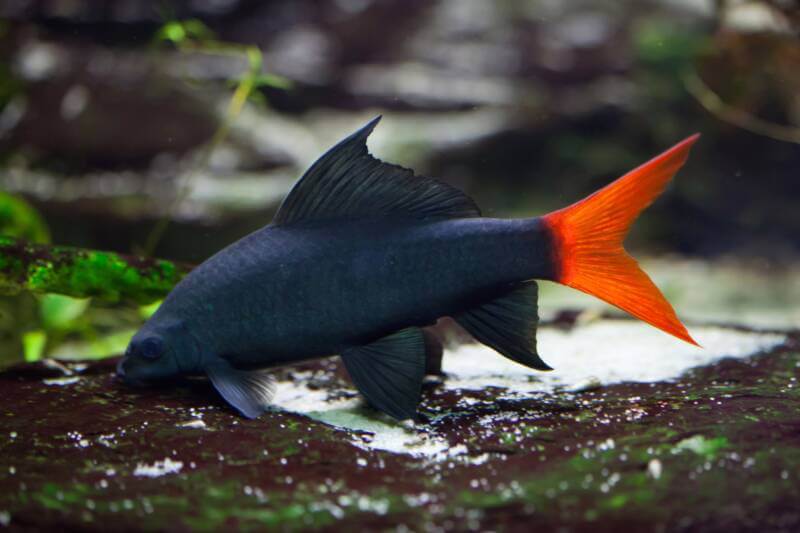There’s no denying that having a freshwater tank shark is really rad!
So, it makes sense why the ever growing popularity of freshwater aquarium sharks has risen.
No one quite knows where the “shark” label came from. But the image is well known, with a sleek, torpedo-shaped body, the high triangular dorsal fin, forked tails, and a snappy, bold personality.
To make your selection easy, we put together a detailed list of the coolest freshwater sharks to keep in your tank. Some reach massive lengths, yet there are a few smaller ones, and there’s no doubt they are all epic!
1. Red Tail Shark
Red Tail Sharks (Epalzeorhynchos bicolor) catch and hold the eye. The vivid ruby-red fins stand out against the midnight black body.
The Red Tail Shark follows the classic shark-like body style with the pointed, triangular dorsal fin, and forked tail.
While popular among freshwater shark enthusiasts, red-tails have a tragic past.
Development along the Chao Phraya River in Thailand, where red-tails come from, has led to the near-extinction of the species. Aquarists rely on captive breeding for their acquisitions. However, breeding is not for the faint of heart and quite a challenging task, making these a rare find for the hobbyist.

Once they reach juvenile stage, they are hardy, and adapt to their environment well. The preferred temperature is between 72-79 Degrees Fahrenheit, so a tank heater will be necessary. The thrive in a neutral pH balance between 6.5 to 7.5.
The natural habitat of red tail sharks is the freshwater lakes and swamps of Thailand. Therefore, a planted aquarium with a variety of vegetation, rocks and wood will keep them happy! These are moderately active swimming fish, who use the entire water column (top to bottom) to glide around. What they prefer is a lengthy tank set-up verses depth, so a 50 gallon tank is the minimum recommended size once adult maturity is reached.
You can only keep ONE red tail shark in a tank, because territorial aggression is common. They’ll attack each other, other sharks, and catfish without hesitation.
- Difficulty: Intermediate
- Adult Size: 6 inches
- Temperament: Territorial-Aggressive
- Diet: Omnivore – Floating (Medium) Pellets & Flakes, Freeze-Dried Whole Foods
- Minimum Tank Size: 50 gal (189L)
Check out our complete care guide on Red Tail Sharks
2. Rainbow Shark
Rainbow Sharks (Epalzeorhynchos frenatum) share a similar appearance to Red Tail Sharks. They have a dark, smokey-gray or bluish body with red-orange fins. The overall coloration in the species is more variant, and the intensity can changes based on the healthiness of their diet. Their fins and tail have a translucent appeal to them, highlighting the prominent ridges that run down the length. A key “mark” that is visible in almost every Rainbow Shark is the black spot found right in front of the tail.
They are also referred to as Ruby Sharks or can be mistaken to be Red Tail Sharks, but none the less they offer a focal point to your freshwater tank! To highlight their punchy show, select a tank with a black background so that the tail and fin colors stand out even more.
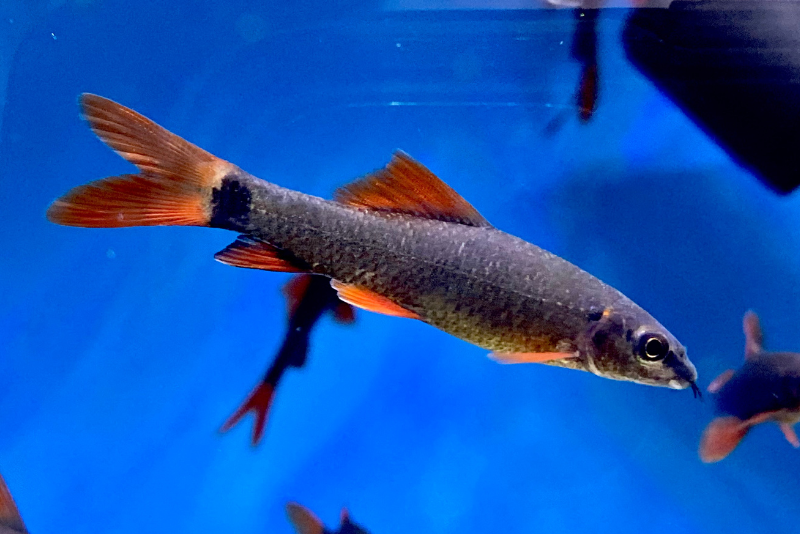
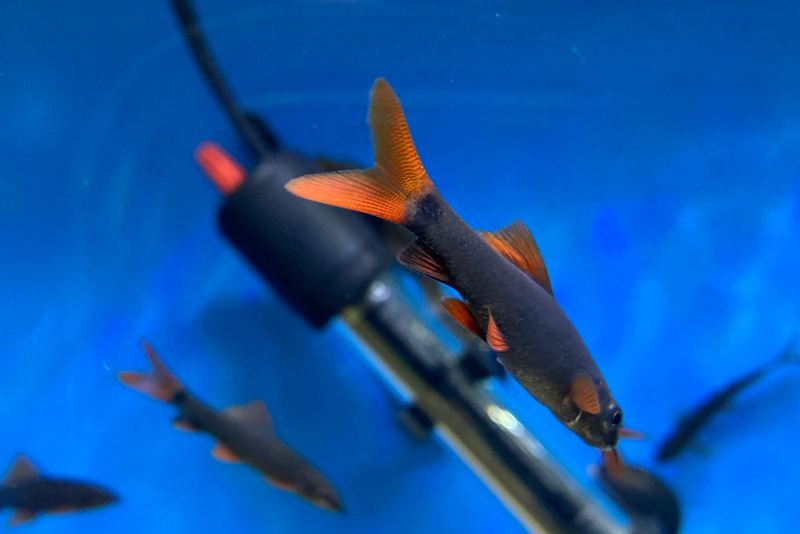
Rainbow Sharks take their shark label seriously, bullying and harassing peaceful and smaller tank mates. Your best bet is to pair them with larger fish that can hold their own against rough treatment. Therefore they are not recommended for a beginner if kept in a community tank.
If you are a beginner, and the Rainbow Shark is exactly what you want – simply keep them in a separate aquarium all on their own.
Rainbow Sharks are moderately active swimmers and primarily stick to the bottom portion of the tank. So, when selecting a tank longer and shallower is best. If you go with a community tank, be mindful to select fish that keep to the top of the tank to minimize territorial conflicts.
The healthy, natural diet of Rainbow Sharks is a mixed omnivore selection. Being bottom dwellers, they spend a lot of time chowing down on algae. So, it’s best to create a dynamic bottom full of different rocks, driftwood, and sticks for the algae to grow on and to offer enrichment. Supplement the diet with sinking wafers, vegetables, freeze-dried foods, and gel cubes.
- Difficulty: Beginner to Intermediate
- Adult Size: 6 to 8 inches
- Temperament: Semi-Aggressive
- Diet: Omnivore – Sinking Wafers
- Minimum Tank Size: 50 gal (189L)
Check out our complete care guide on Rainbow Sharks
3. Albino Rainbow Shark
This is the Albino version of the Rainbow Shark. It has a white body, giving it an almost ghost/glass fish feel, with the similar fire-orange fins and tail. Some Albinos have a pinkish hue making the a sought after choice for your aquarium. One characteristic that can freak you out is they often have ruby-red eyes! The care is the same as the classic smokey-gray body Rainbow Fish, but offer a rare, unique feature.
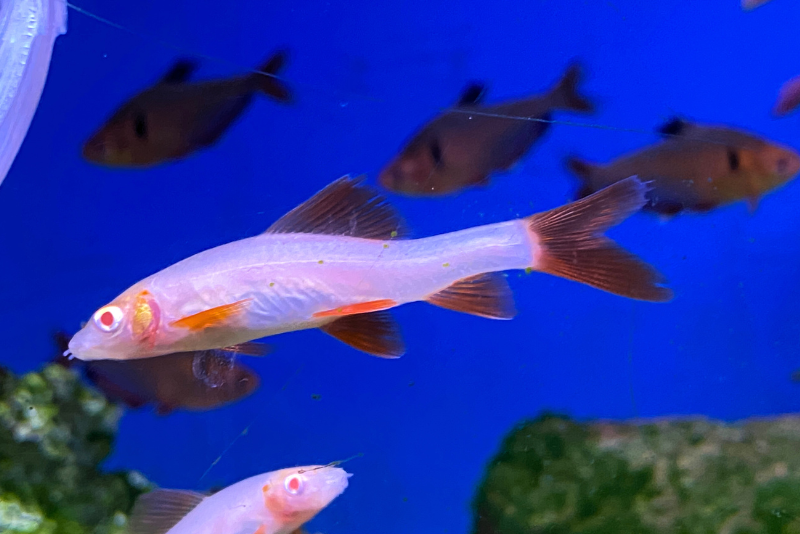
- Difficulty: Beginner to Intermediate
- Adult Size: 6 inches
- Temperament: Semi-Aggressive
- Diet: Omnivore – Sinking Wafers
- Minimum Tank Size: 50 gal (189L)
4. Bala Shark
Bala sharks (Balantiocheilos melanopterus) make frequent appearances in hobbyist’s aquariums. The gray shining scales with contrasting black borders, and jet black edging on the fins and tail, make them attractive additions to many aquarists. You won’t see much variation in the Bala Shark coloration.
It’s a fair argument that Bala Sharks look intimidating, just like the Jaws of the ocean, however they are gentle, curious, freshwater tank sharks.
Unfortunately, people don’t realize those little, adorable juveniles will quickly grow to over 12 inches (30cm) long! So plan for the future of your Bala Shark community and opt for a large aquarium.
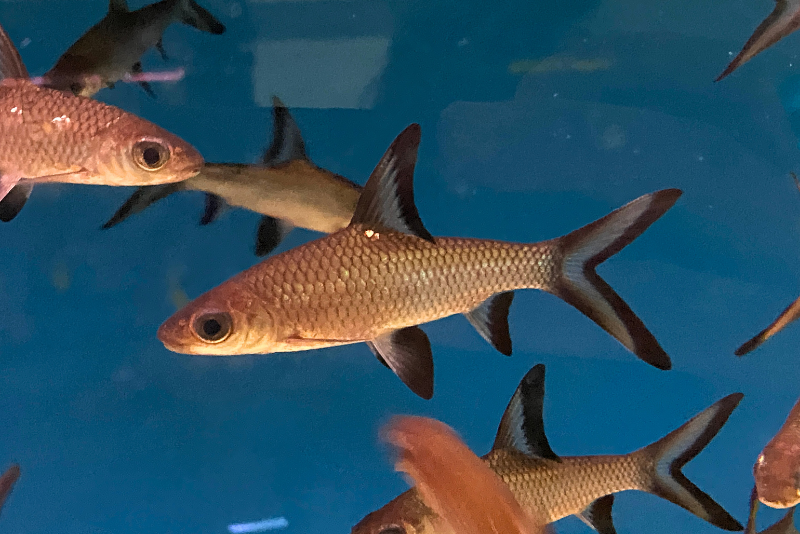
These striking sharks are extremely active swimmers, one of their desired qualities. They will spend hours swimming about the entire aquarium. A diverse, enriched aquarium is essential for a happy fish. When kept in groups of three or more, they will swim and school together.
Even with friends around, don’t be surprised to find your sharks testing the lid of the tank. Make sure you have a tight fit, so no one ends up on the floor! Beyond that they aren’t too difficult to care for, making them suitable for intermediate level experience. Though, they will require a very large tank that maintains a temperature of 77 degrees Fahrenheit.
Bala Sharks thrive on a high-quality omnivore diet. Variety, and high-quality protein is essential! Feel free to offer snacks of freeze-dried bloodworms, brine shrimp, and krill. The base of the diet can be pellets and flakes that are medium sized. Bala sharks have a ravenous appetite and do best when fed three times a day.
- Difficulty: Intermediate
- Adult Size: 10-13 inches
- Temperament: Peaceful, Curious & Social
- Diet: Omnivore – Medium Flakes, Pellets, Freeze-Dried Whole Foods. High Intake Needed
- Tank Size: 125 gal (473L) and at least 4′ (1.2m) long
5. Roseline Shark
Roseline sharks (Sahyadria denisonii) rank as the easiest freshwater shark to manage.
If you have your heart set on a freshwater shark but don’t want to invest in a gigantic aquarium, Roseline Sharks fit the bill. Best of all, they only reach a length of 4 inches (10cm) as adults! They are apart of the Barb family and will be the smallest tank shark you can get.
These colorful fish brighten any aquarium! With a prominent fire-red stripe that starts at the tip of their nose and fades out about midway down the body. A jet black stripe starts just below the red one and continues the entire length of the body. The tail is forked, with an orange and black stripe midway down.
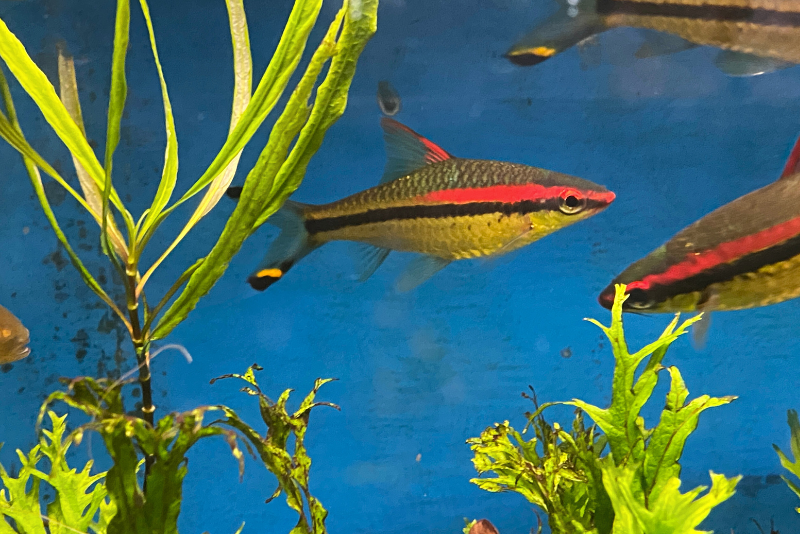
That said, Roseline Sarks need schools to stay happy and healthy. You’ll want at least four to six in the group, which will demand a larger tank set up but well worth it because you will enjoy their playful schooling behavior. Aggression will not be a problem as these are quite peaceful, active fish. So, feel free to mix with other fish species for a colorful aquarium.
Tank and water requirements are easy, as they are hardy and can tolerate temperatures between 60 to 77 degrees Fahrenheit. If you live in a hot climate however, you might need to invest in an aquarium chiller to keep the needed cooler temperatures. A strong current is preferred, as their native environment is rivers and streams with active, bubbling water. This can be achieved with a strong pump that has flow capacity.
When you hit the store, make sure you get captive-bred. The Roseline Shark is endangered in their native waters of India, and you don’t want to contribute to the dwindling numbers.
So if you’re getting your feet wet, they’re your best bet as a starter species. Their water conditions aren’t demanding, and they aren’t picky when it comes to diet.
- Difficulty: Easy
- Adult Size: 4.5 inches
- Temperament: Peaceful
- Diet: Omnivore
- Minimum Tank Size: 40 gal
6. Black Shark
The Black Shark (Labeo chrysophekadion) may not have much in the way of flashy colors, but their midnight, purplish-black color and flowing fins make for a striking appearance.
Selective breeding has also produced an albino version if you want something more unique.
When it comes to size, the shark claim a big bite of the prize.
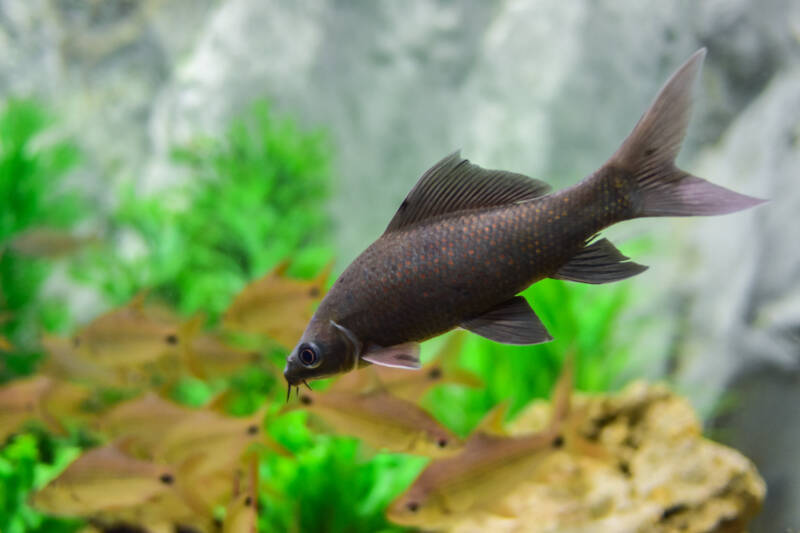
Topping out around 24 inches (61cm) and 25 pounds (11kg), your tank needs plenty of room for these sharks to roam.
Tank mates better be fast enough or of comparable size to compete! Unfortunately smaller fish will be seen as a snack.
If you opt for a Black Shark, make sure it’s the LAST fish you add to the aquarium. If you try introducing newcomers after your shark, it’ll become hyper-aggressive and attack the new fish infringing on its territory.
Their healthy diet is that of an omnivore, but large size and enough portions will be the key. Feed live foods, frozen, and larger sized whole freeze-dried foods along with a large sized pellet. You might find them eating your aquarium vegetation from time to time as well.
- Difficulty: Intermediate
- Adult Size: 24 inches
- Temperament: Semi-Aggressive
- Diet: Omnivore – Large Food, Fresh, Frozen, Pellet & Wafers, Freeze-Dried Whole Food
- Tank Size: 180 gal (681L)
7. Iridescent Shark
Iridescent Sharks (Pangasionodon hypophthalmus) are a major commitment! At adult size, they are giants reach a staggering 36 inches (91cm) when full-grown! Not only that, but these fish can live up to 20 years. Unfortunately, iridescent sharks don’t belong in the average home aquarium.
Most people see juvenile iridescent sharks in pet stores and jump at the chance to include freshwater sharks in their aquarium. Why? Because the purple-black iridescence, flecked with tones of white, looks intriguing, and the fish generally don’t break the bank.
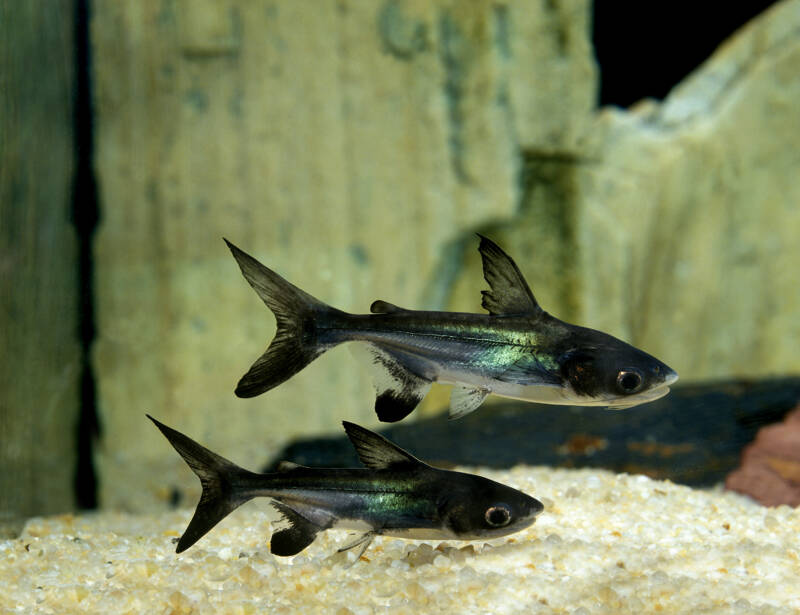
As adults, they have a muted, dull gray color that is smooth, similar to the giant ocean shark look-a-likes. A unique characteristic is the eye is at the bottom of the head, making it look almost as if they are upside down.
Given the long lifespan, Iridescent Sharks grow relatively slow. But with that, many people will get these fish, they out-grow the tank and they end up donated to a large aquarium or zoo.
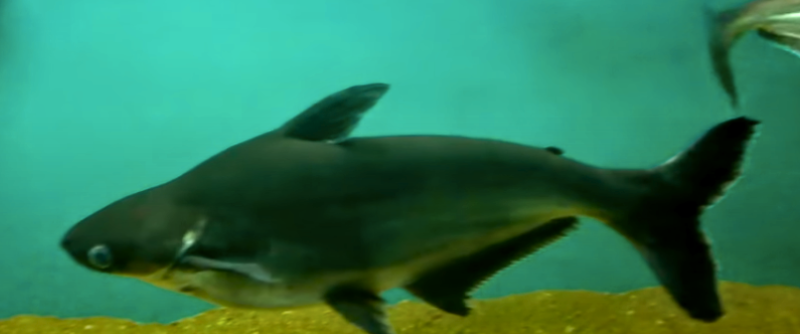
Iridescent sharks share ancestry with the Mekong giant catfish (Pangasionodon gigas). They reach lengths of 10 feet (3m), holding the title of one of the longest freshwater fish in the world.
- Difficulty: Professional
- Adult Size: 36 inches or more
- Temperament: Peaceful
- Diet: Omnivore
- Minimum Tank Size: 300 gal (1135.6L) or MORE
8. Colombian Shark
Colombian sharks (Ariopsis seemanni) have a silvery blue coloring that many aquarists find appealing.
They’re a predatory species of catfish, selecting a variety of foods for their diets is essential. That includes tank mates small enough to fit in their mouths, so be careful.
Beyond that they are peaceful, busy fish that will spend all hours of the day scavenging the tank. Their preference is to keep in the mid to bottom portion of the tank. Colombian Sharks are great community fish, if they are of similar size, however the best tank mates are other Colombians.
While not the most challenging freshwater shark to care for, Colombians throw aquarists a twist.
As adults, they require a transition to brackish and then saltwater. Which means you need THREE large tanks prepped and ready to go!
Not to mention these fish can live 10 to 15 years.
Keeping the tank clean will be essential to overall health. So, invest in a strong, high output canister filter that can effectively clean over 100 gallons. As well, they will need high flow current in the tank that is highly oxygenated.
- Difficulty: Easy – Beginner
- Adult Size: 10-14 inches
- Temperament: Peaceful
- Diet: Omnivore
- Tank Size: 75 gal (284L) for Single Fish
9. Chinese High-Fin Banded Shark
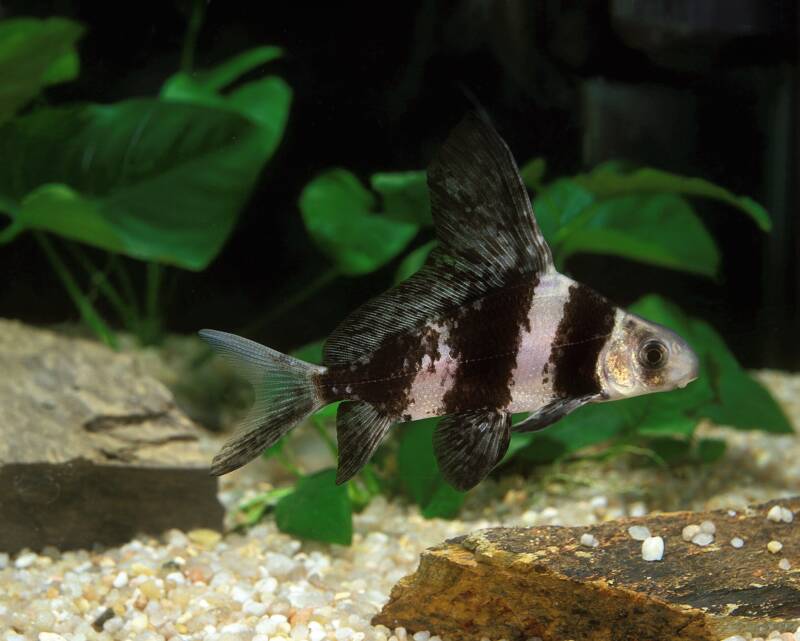
People that select Chinese High-Fins (Myxocyprinus asiaticus) gravitate toward the juveniles.
Youngsters have attractive bands of brown and black on a peach background with that recognizable sail dorsal fin arching over the back. Adults? Not so much.
Unlike most fish, Chinese High-Fins gradually lose their color over the first two years.
Adults switch over to drab coloring, and the sucker-type mouth becomes more prominent. They look similar to the Chinese Algae Eater.
In China, this freshwater shark falls on the endangered list.
Aquarists procure the cold-water species from captive-bred ponds.
That aversion to warm temperatures contributes to the decline of the species in the wild. (Climate change is NOT a good thing!)
- Difficulty: Expert
- Adult Size: 4 Feet, 121 cm
- Temperament: Peaceful
- Diet: Omnivore
- Tank Size: 300 gal (1135.6L) or MORE
Harlequin sharks (Labeo cyclorhynchus) have a dappled patterning that mimics sunlight and shadows passing through tangles of weeds. With a soft orange base color, the koi like muddled dapples are scattered on top – making each fish unique in its pattern.
As this species prefers to hang out along the bottom, the coloring makes perfect sense. It also adds a nice touch of color to your aquarium. However, this fish is a solitary species that can be skittish, fast to find a hiding place.
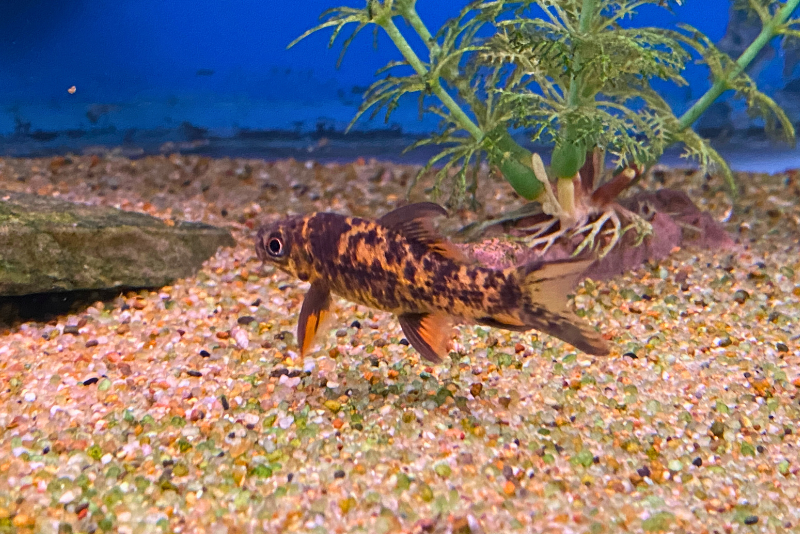
Harlequins are territorial. You need to make sure you provide a cave or grotto to prevent them from claiming the entire bottom of the tank as their own. In their natural, wild habitat of the Congo River Basin, Harlequin Sharks hide amongst the densely planted forest streams. They love caves, nooks, piled rocks or driftwood and hardy plants.
DON’T add other bottom-dwellers to your aquarium unless you want to cause trouble. Harlequin sharks WILL attack more defenseless catfish, cory without a second thought.
As they are bottom-dwelling fish, you will need to feed them sinking wafers to supplement the preferred algae that they will spend the day collecting off the bottom. They will also eat many things that fall to the tank bottom.
- Difficulty: Intermediate
- Adult Size: 6 inches
- Temperament: Territorial, Aggressive
- Diet: Omnivore – Sinking Wafers, Gel Cubes, Freeze-Dried
- TankSize: 40 gal (189L)
11. Silver Apollo Shark
Silver Apollo sharks (Luciosoma setigerum) sport a sleek torpedo shape with shining silver scales.
That shape helps them cut through the middle and top of the water column. You’ll want to make sure you have plenty of water current to keep them happy.
While you might get away with keeping a single silver Apollo in a smaller tank, they ARE schooling fish. You need a minimum of six.
And make sure the lid’s on tight because silver Apollos have phenomenal jumping abilities!
Read the label carefully when you buy your sharks. The long-finned Apollo shark (Luciosoma spilopleura) looks VERY similar.
However, long-finned are solitary and aggressive. If you introduce it to the group, it will kill the others.
- Difficulty: Intermediate
- Adult Size: 7 inches
- Temperament: Peaceful
- Diet: Omnivore – Sinking Wafers, Gel Cubes, Frozen Foods
- Tank Size: 150 gal (568L)
Freshwater Shark Tank Setup
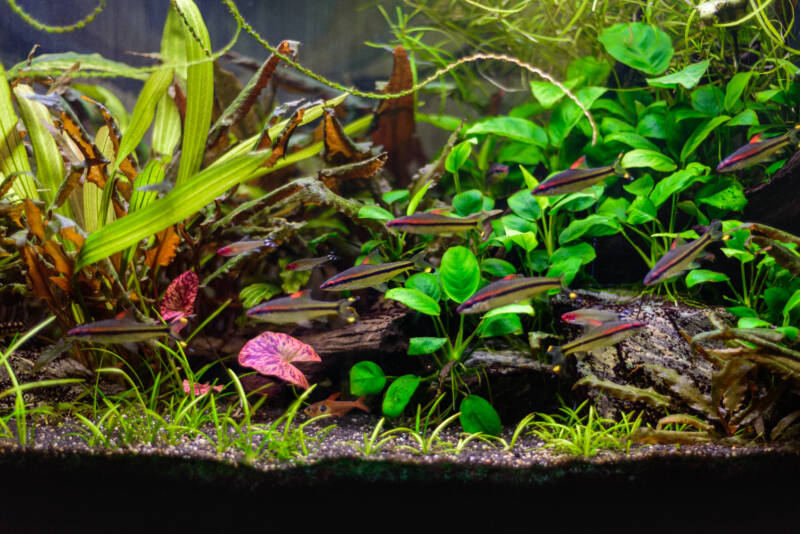
Freshwater sharks share another common characteristic with their marine “cousins”: a tolerance for varying water conditions.
Most species prefer warmer waters, but there are exceptions.
Be sure to research your shark’s needs before you bring it home.
| Species | Temperature | pH |
| Bala Shark | 77-80°F 25-26.6°C |
6.5-8.0 |
| Black Sharkminnow | 72-82°F
22.2-27.7°C |
6.5-7.5 |
| Chinese High-Fin Banded Shark | 55-75°F 12.7-23.8°C |
6.8-7.5 |
| Colombian Shark | 75-80°F 23.8-26.6°C |
7.0-8.0 |
| Harlequin Shark | 72-81°F
22.2-27.2°C |
6.0-7.5 |
| Iridescent Shark | 72-79°F
22.2-26.1°C |
6.5-7.5 |
| Rainbow Shark | 72-79°F
22.2-26.1°C |
6.5-7.5 |
| Red Tail Shark | 72-79°F
22.2 -26.1°C |
6.5-7.5 |
| Roseline Shark | 60-77°F
15.5 -25°C |
6.6-7.8 |
| Silver Apollo Shark | 72-78°F
22.2-25.5°C |
6.0-6.5 |
While these species have significant tolerances for temperature and pH, they require pristine water conditions.
NEVER introduce a freshwater shark into an aquarium that you’re struggling to stabilize.
This is one of the reasons beginners should avoid freshwater sharks.
While freshwater sharks may tolerate an occasional spike in ammonia or nitrites, the window is narrow. The amount of variance is even shorter.
Your ammonia can’t go higher than 0.02 ppm, and your nitrites no higher than 0.2 ppm.
What do Freshwater Tank Sharks Eat?
While freshwater sharks may snatch up a tank mate without hesitation, these species are omnivores.
Many of the catfish in the group have sucker-type mouths designed to rasp algae from rocks and driftwood in the tank. (Your fingers are safe)
Even the toothy varieties enjoy some plant-life in their diet.
Rotating between frozen and live foods improves their color and growth.
A selection of different foods keeps these sharks happy:
- Algae rounds
- Bottom feeder tablets
- Flake foods
- Shrimp pellets
When is a Shark Not a Shark?
Freshwater sharks might not pose a risk to fingers or toes that dip into the aquarium.
However, their unique appearance still adds character to your tank. And with the extra demands of their care, you earn respect from fellow aquarists whenever you mention owning freshwater shark species.
Have you entered the freshwater shark craze?

